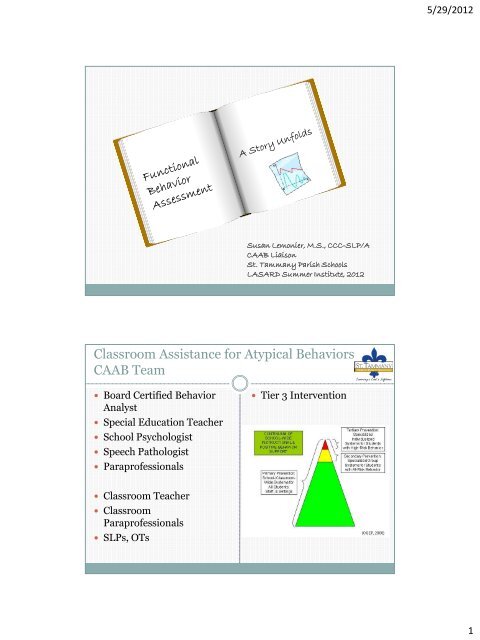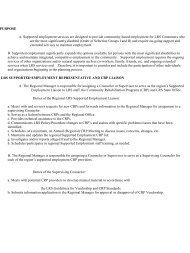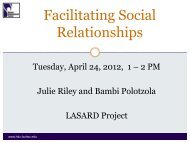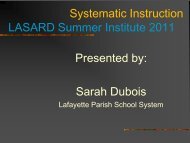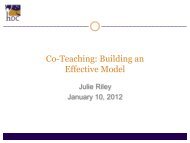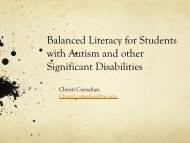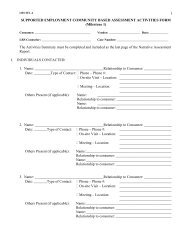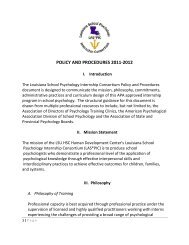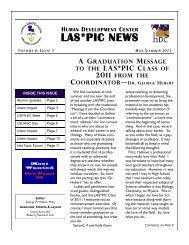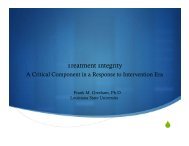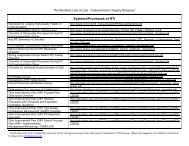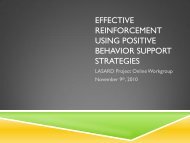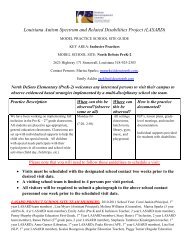Functional behavior assessment: A story unfolds
Functional behavior assessment: A story unfolds
Functional behavior assessment: A story unfolds
- No tags were found...
Create successful ePaper yourself
Turn your PDF publications into a flip-book with our unique Google optimized e-Paper software.
5/29/2012Susan Lemonier, M.S., CCC-SLP/ACAAB LiaisonSt. Tammany Parish SchoolsLASARD Summer Institute, 2012Classroom Assistance for Atypical BehaviorsCAAB Team• Board Certified BehaviorAnalyst• Special Education Teacher• School Psychologist• Speech Pathologist• Paraprofessionals• Tier 3 Intervention• Classroom Teacher• ClassroomParaprofessionals• SLPs, OTs1
5/29/2012Tier 3 Interventions• High Intensity Behaviors◦ Physical Aggression (i.e. hitting, kicking, slapping,punching adults or peers)◦ Property Destruction (i.e. throwing, breaking, tearingitems)◦ Elopement (i.e. leaving a designated area, running away fromadult, entering an unsafe area)◦ Self-Injury (i.e. slapping self, punching self with fist, hittingbody parts against other objects, picking or pinching skin,biting body parts)2
5/29/2012……..Miracle Workers<strong>Functional</strong> Behavior Assessment3
5/29/2012ComponentsData………• Review of Medical/PsychiatricHi<strong>story</strong>• Review of School Records• Parent Interview• Teacher Interview• Student Interview• Observations• Data Collection• Graphing Data• Hypothesis StatementStudent PreferencesShannon• 8 years old, second grade• Medical Diagnosis of Autism• 1508 Exceptionality of Autism• Included in art, PE, music, lunch, recess with typicalpeers with paraprofessional support• Partial participation in science/social studies withparaprofessional support• OT, Speech, APE• ABA Therapy 3 times/week for 14 hours4
5/29/2012Shannon• Teacher reports escalating episodes of self-injury:Topography- What does the <strong>behavior</strong> look like?-an open left hand hit to the left side of the foreheadnear the hair line, audible up to 10 ft.Staff provides baseline data-A-B-CABC• Antecedent- environmental conditions or stimuluschanges that exist or occur prior to the <strong>behavior</strong>.• Consequence- a stimulus change that that follows the<strong>behavior</strong>.5
5/29/2012ABC Data Collection FormFBA Baseline Data6
5/29/2012AntecedentsConsequences7
5/29/2012<strong>Functional</strong> Assessment InterviewsParentTeacher• Good artist, likes toread on the computer• Uses verbal language,whispers, difficult tohear• Loves to draw, enjoysreading computerprograms• Can use verballanguage, but oftenpinches or grabs to askfor things he wants,whispers<strong>Functional</strong> Assessment InterviewsParent• Behavior of Concern◦ an open left hand to theleft side of the foreheadnear the hair line, audibleup to 10 ft.◦ Hits head up to threetimes before blocked◦ Leaves a pink/red mark◦ Occurs several times/dayTeacher• Behavior of Concern◦ an open left hand to theleft side of the foreheadnear the hair line, audibleup to 10 ft.◦ Hits head up to three or 4times before blocked◦ Leaves a red mark, somebruising◦ Occurs an average of 9times/day8
5/29/2012<strong>Functional</strong> Assessment InterviewParentTeacher• Most likely to occur whenasked to do something hedoesn’t want to do orwhen I take somethingaway or when sick, tired• Least likely to occur ifleft alone• Lasts until I block it- Ifnot, up to 2 minutes.• Most likely to occur inresponse to adult requestor transition to noisyareas, change in routine• Least like likely to occurduring a preferredactivity; computer, swing• Lasts until protocol isused, a few seconds<strong>Functional</strong> Assessment InterviewParentTeacher• To get something?◦ No• To get something?◦ No• To avoid something?◦ Yes, what I want him todo.• To avoid something?◦ Yes, adult requests9
5/29/2012HypothesisReview All Data to Generate Hypothesis:• Description of Behavior• The <strong>behavior</strong> of concern is: Self Injury• It most often occurs during: task demands and transitions and noisy areas• It occurs with a frequency of 0-9 times per day depending on the length of the school day• It typically lasts from 3 seconds to 2 minutes.• Description of Setting Events and Antecedents• The most likely setting event(s) for the <strong>behavior</strong> of concern includes: tired, sick, allergiesaversive environments• The most likely antecedent(s) for the <strong>behavior</strong> of concern includes: task demand, free time,activity denied• Description of Consequences• The most likely consequence(s) for the <strong>behavior</strong> of concern includes: protocol, ignore• Perceived Function• It appears that the student engages in <strong>behavior</strong> to escape adult requests.Hypothesis Statement• Shannon engages in◦ Hitting his left side of his forehead near the hair with an openhand that is audible up to 10 feet for up to three minutesToEscape adult requests.10
5/29/2012Replacement Behaviors• ACCEPTABLE ALTERNATIVE BEHAVIOR◦ Short Term: <strong>Functional</strong> Communication Training(FCT) Adult will model and prompt phrases toexpress wants and needs, “I need help.” “I need abreak”. (data collection)◦ Long Term: <strong>Functional</strong> Communication Training(FCT)Shannon will independently was phrases to expresshis wants and needs, “I need help.” “I need a break.”(data collection)11
5/29/2012Positive Behavior Intervention Plan (PBIP)●Interventions (Preventative)◦ Individualized visual schedule◦ Preferred Activities (choices) embedded into schedule◦ Compliance training◦ Least to most prompting◦ Non-contingent reinforcement◦ Contingent (Differential Reinforcement)◦ FCT (modeling and prompting) “I need a break.” I want ___.”●Interventions (Reactive) RED ZONESIB during instructional request- block and continue taskSIB when there is no demand, “Hands on pants.” Praise after 10seconds with out SIB.Intervention Data12
5/29/2012Intervention DataIntervention Data13
5/29/2012References• Vismara, L.A. & Rogers, S.J. (2007). Teaching Approaches withDemonstrated Success. Early Intervention, American Society ofAutism.• Tilly, W. D., Knoster, T. P., Kovaleski, J., Bambara, L.,Dunlap, G., & Kincaid, D. (1998). <strong>Functional</strong> <strong>behavior</strong>al<strong>assessment</strong>: Policy development in light of emergingresearch and practice. Alexandria, VA: NationalAssociation of State Directors of Special Education(NASDSE).• Sugai, G., Lewis-Palmer, T., & Hagan. S. (1998). Usingfunctional <strong>assessment</strong>s to develop <strong>behavior</strong> support• plans. Preventing School Failure, 43(1), 6-13.• Cooper, J., Heron, T., Heward, W.; Applied BehaviorAnalysis, Second Edition, Merrill Prentice Hall, p. 2814
5/29/2012Online Resources• Louisiana Autism Spectrum and Related DisabilitiesProject(LASARD)• http://www.hdc.lsuhsc.edu/lasard/index.html• Louisiana Autism Spectrum and Related DisabilitiesProject(LASARD) Training Modules• http://www.laqitm.org/15


